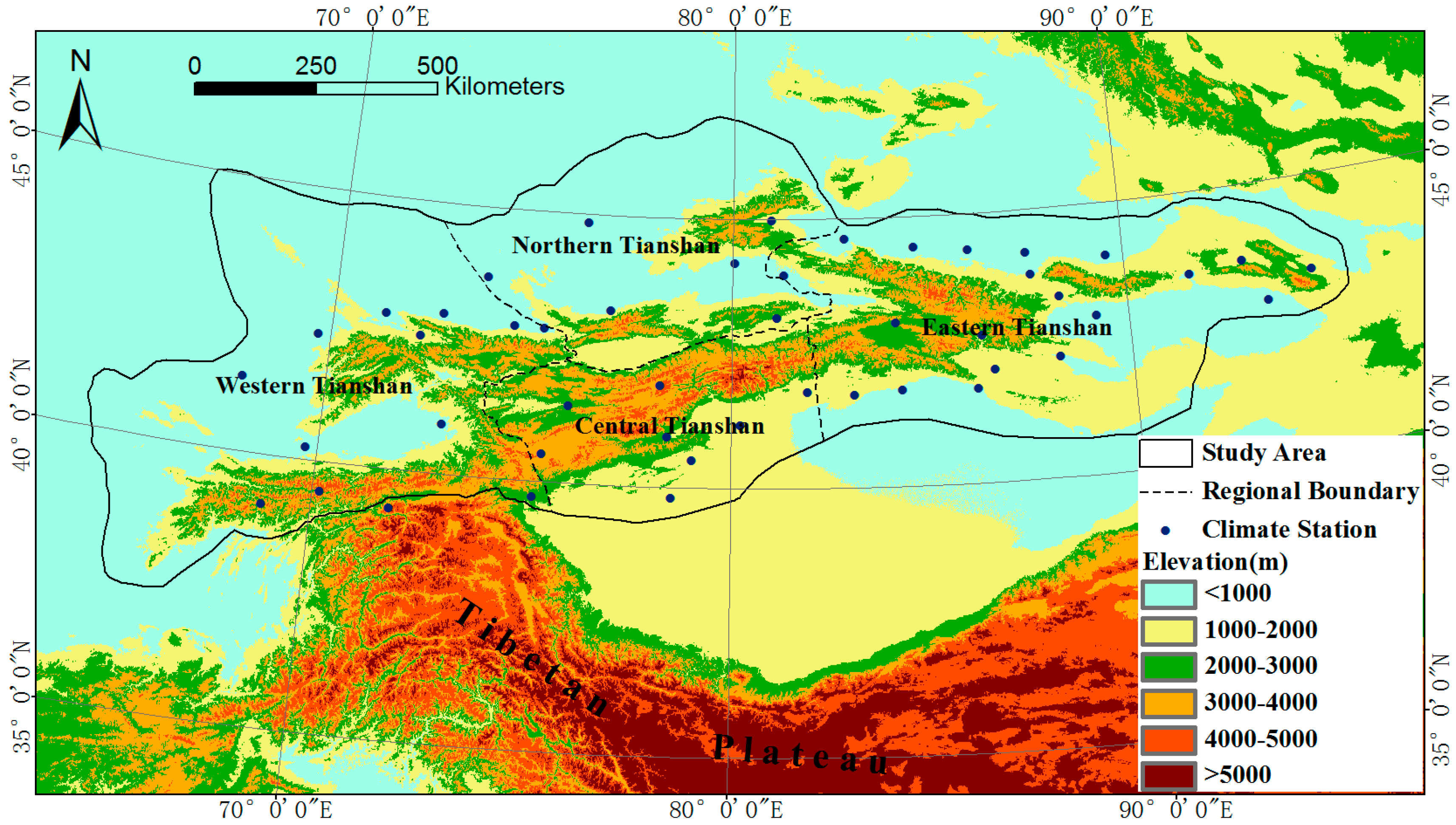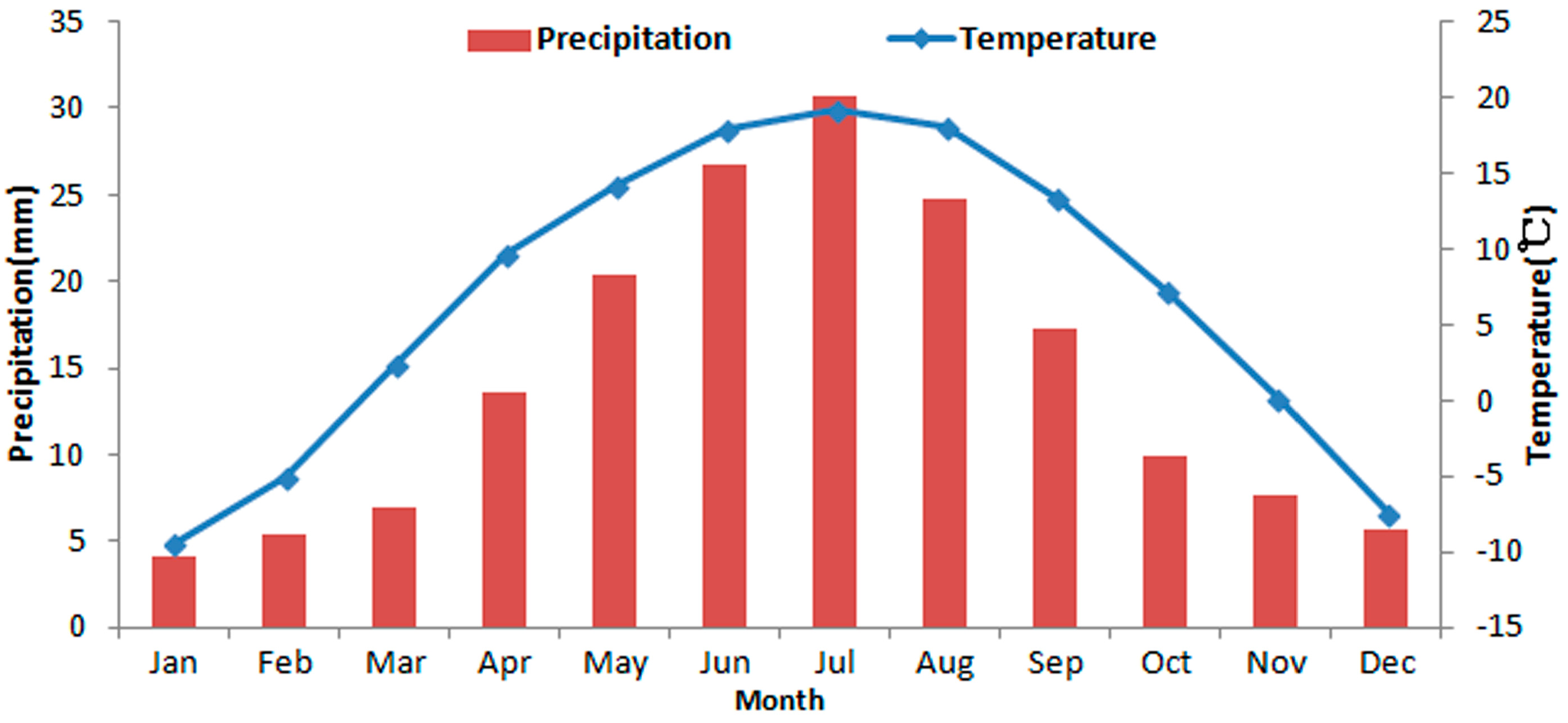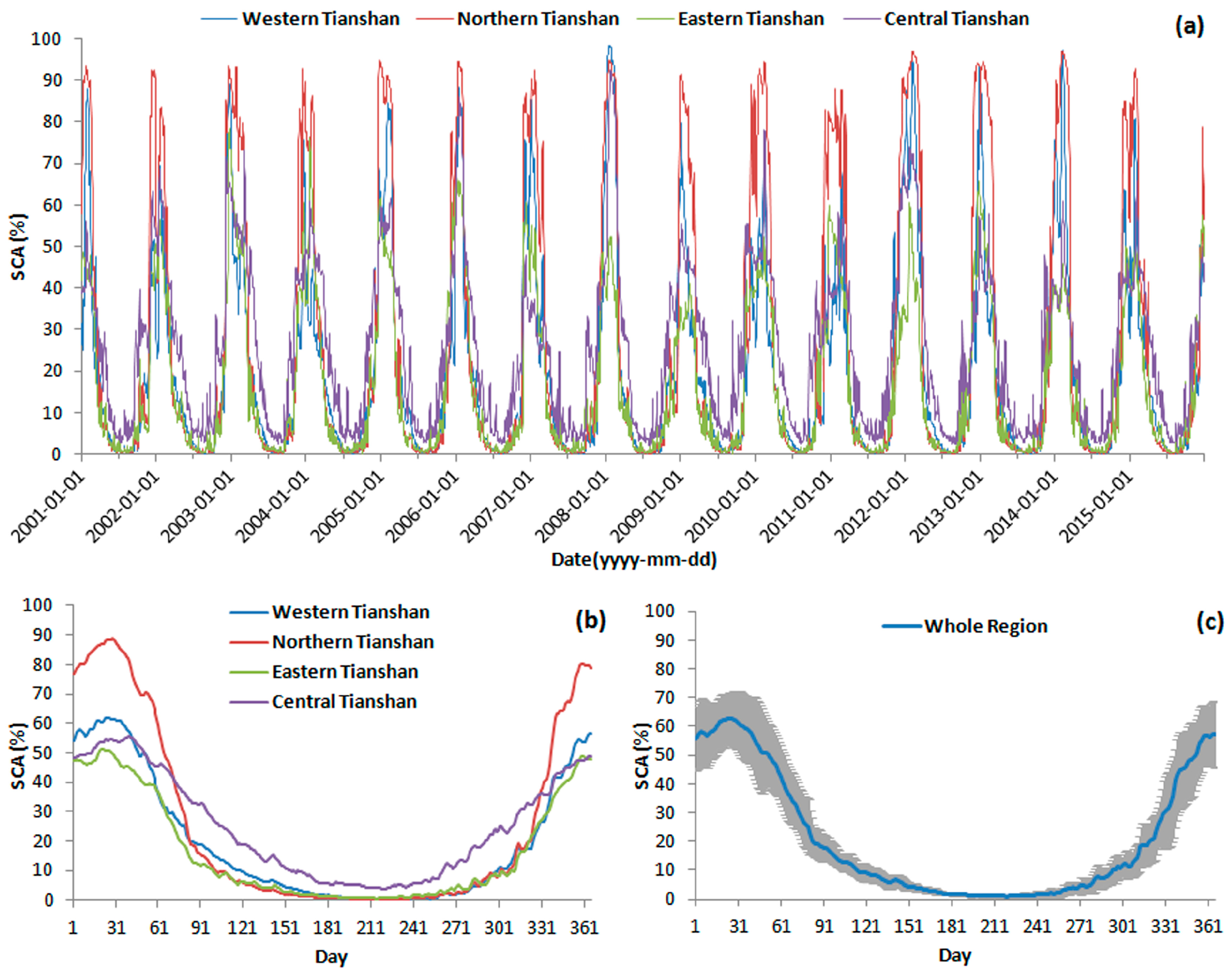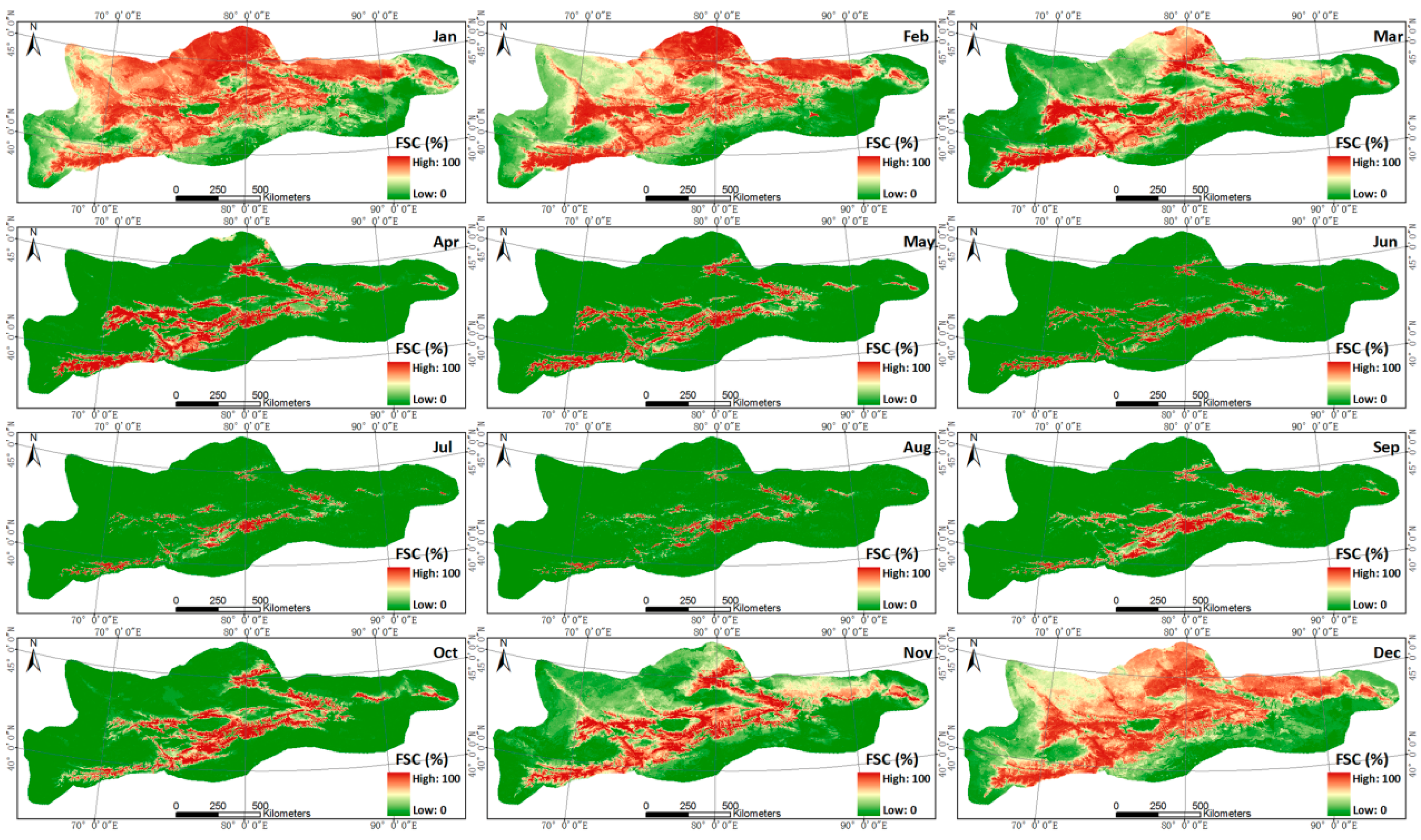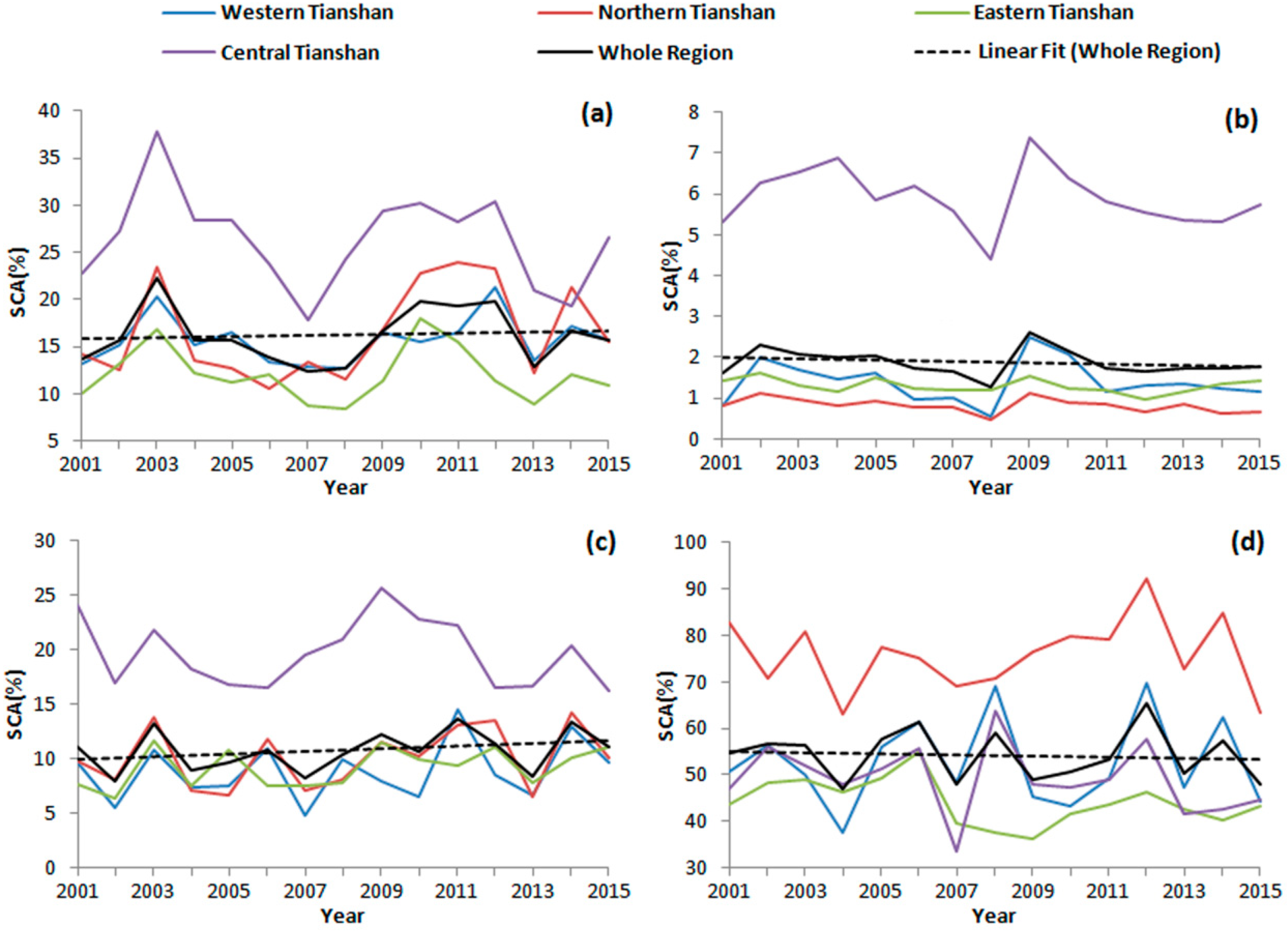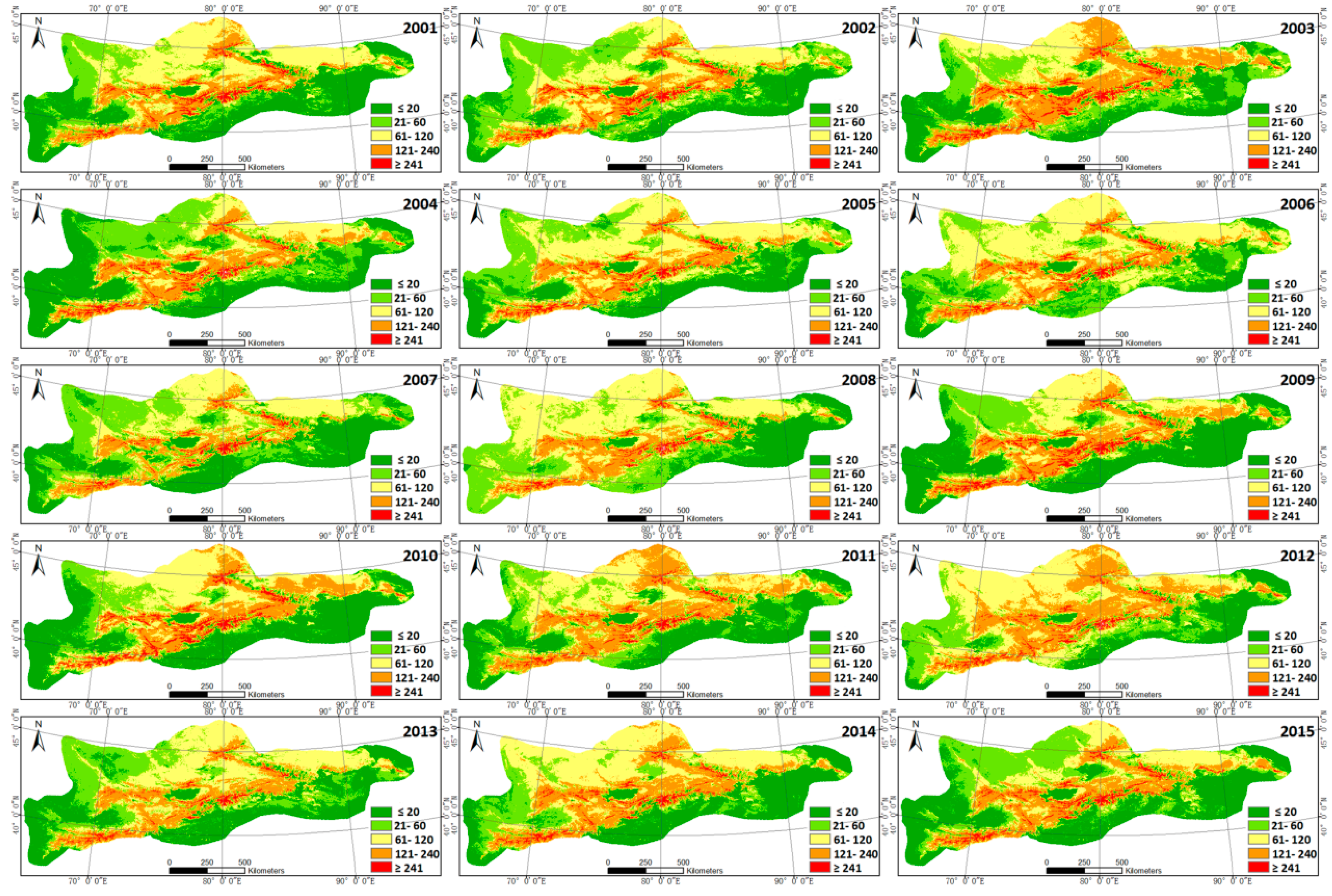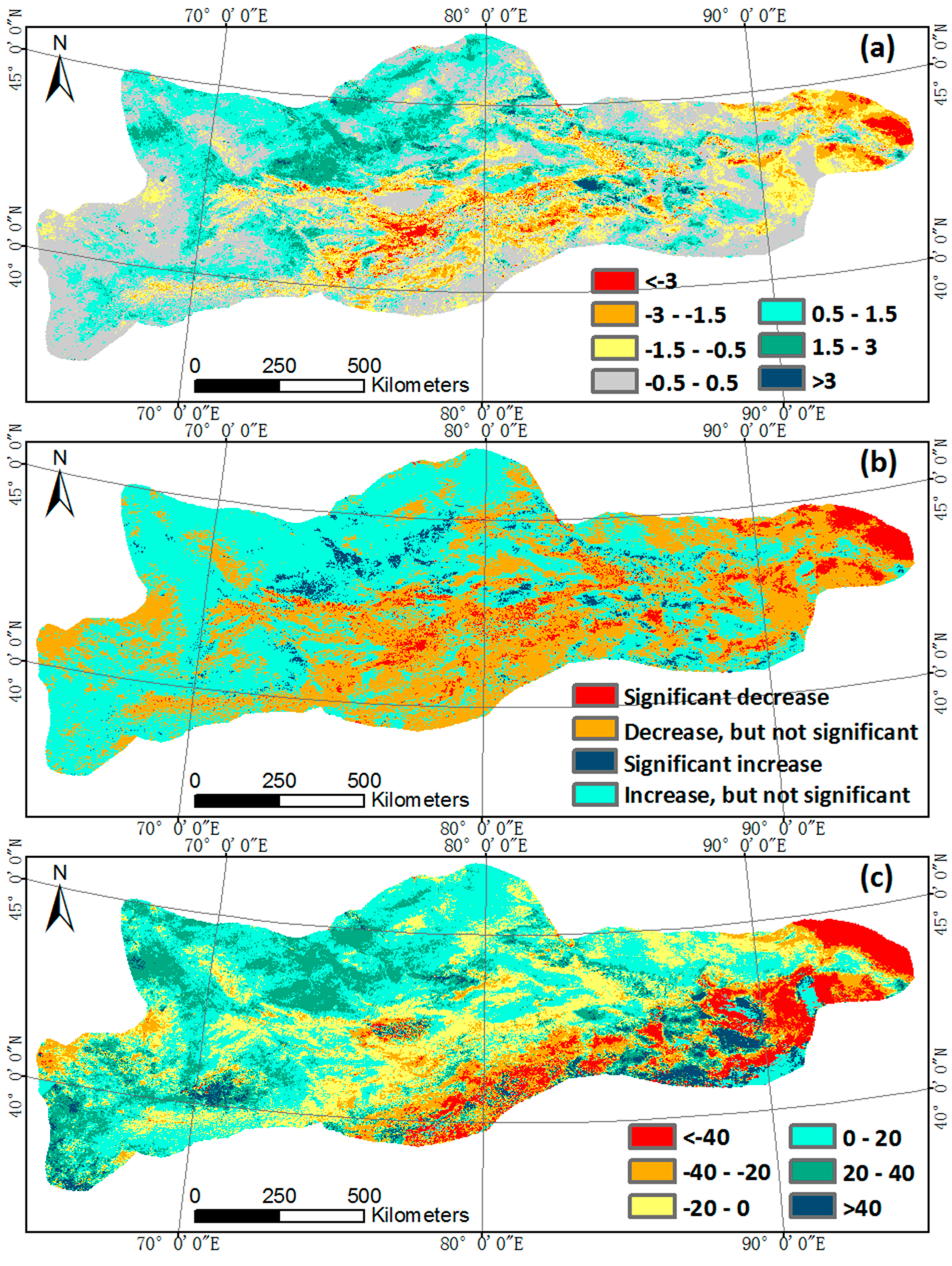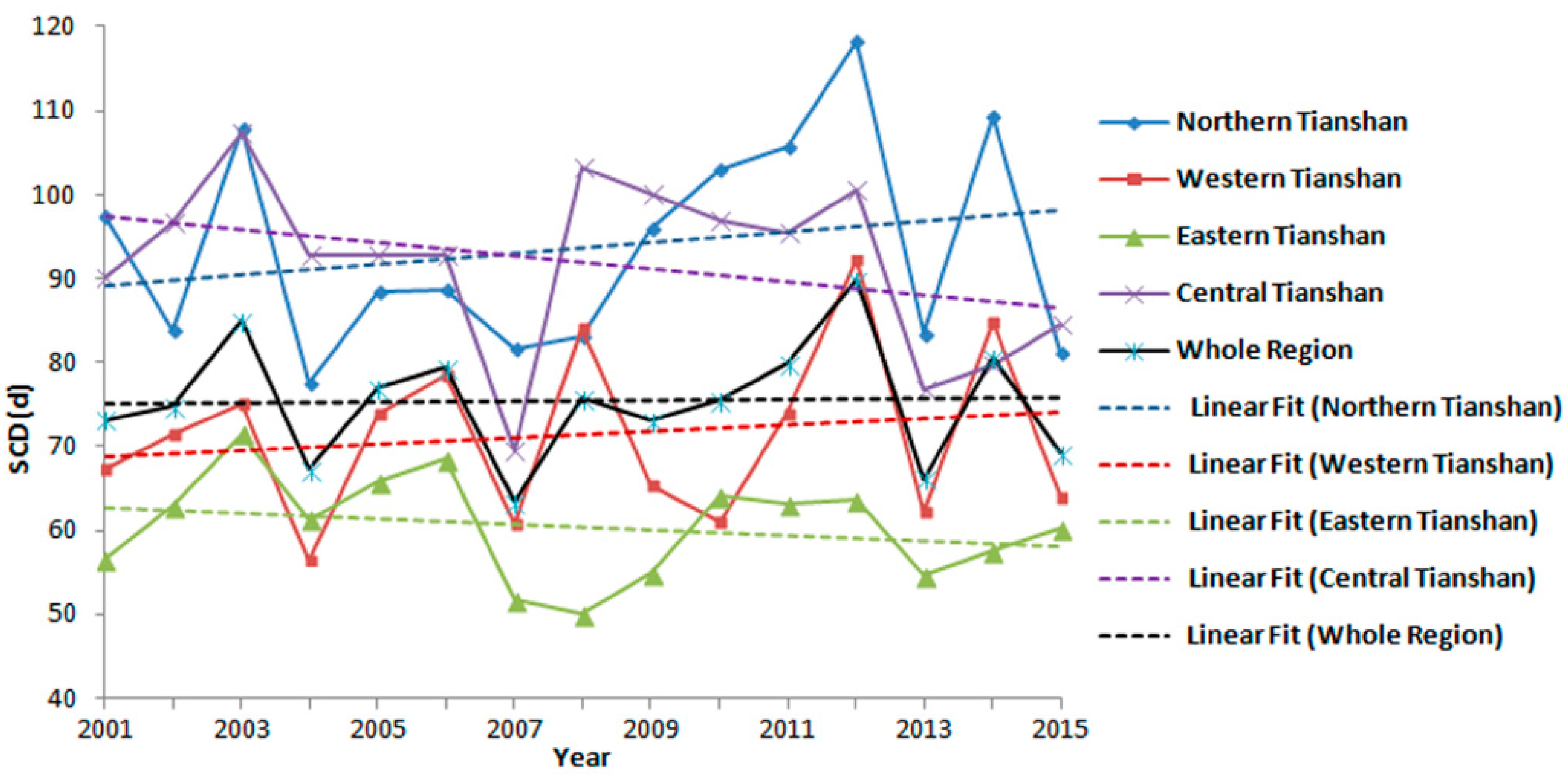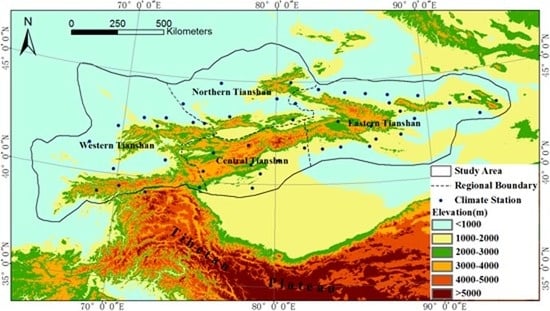1. Introduction
Snow cover, as an important component of land cover, is one of the natural materials on the Earth’s surface with wide distribution, obvious seasonal variation, and high sensitivity to climate change [
1]. Snow plays an important role in the global energy and water cycles because of its high albedo and thermal and water storage properties, and can indicate the changes in global climate [
2,
3,
4]. Studying snow cover variation is of great importance in monitoring and maintaining water management for ecosystem processes and irrigation practices [
5]. For example, in arid and semi-arid regions of Western China, snow cover is a very important water resource, since water from melted snow forms the headwaters for several of the largest rivers in Asia. In these regions, the snowmelt water is dominant among all water sources [
6]. Consequently, snow can also largely influence agriculture and animal husbandry [
7,
8]. More importantly, more than one sixth of the global population relies on water from mountainous snowmelt [
9].
The Tianshan Mountains, as the water tower of Central Asia [
10], are the source of major rivers in Central Asia (e.g., the Chu River, Syr Darya River, Ili River, Tarim River and others). They have attracted a large amount of attention for climate and cryosphere studies during the past decades; being consistent with the global warming, most mountain glaciers and glacial lakes in Tianshan Mountains are in a state of rapid change [
11,
12,
13]. Snow cover in Tianshan Mountains, is an important predictor of regional climate change, as well as a crucial water source for its surrounding arid regions, and greatly influences the hydrological and biological processes. The snowmelt water from Tianshan Mountains is the lifeblood of agriculture and animal husbandry in its downstream arid regions [
14]. Particularly, in Xinjiang, the big agricultural province of China, the rivers runoff comes from the Tianshan Mountains is 474 × 10
8 m
3, accounting for 53.6% of the total rivers runoff in Xinjiang Province [
14]. However, due to the scarcity and limitation of meteorological station, the in-situ snow cover observations are difficult to adequately quantify the spatiotemporal variability of snow cover in the mountainous regions [
15,
16]. There should be many uncertainties and incompleteness in those previous studies that only applied in-situ observations to monitor the long-term snow cover change in the Tianshan Mountains [
17,
18,
19,
20,
21]. Therefore, an updated and exhaustive analysis of spatiotemporal variation of snow cover in the Tianshan Mountains is necessary.
Recent technological advances in satellite remote sensing have allowed remote sensing data to extract the information of snow cover in the inaccessible areas with rugged terrain and hostile climate [
16]. The most recent and advanced remote sensing snow cover product is produced by the Moderate Resolution Imaging Spectroradiometer (MODIS) flown on the Earth Observing System (EOS) Terra and Aqua platforms, is launched in 1999 and 2002, respectively [
22,
23]. A suite of MODIS snow cover products [
24], including binary snow cover map (snow or non-snow) and fractional snow cover (FSC) map at various spatial and temporal resolutions, have been widely used to depict the spatiotemporal patterns of snow cover in mountainous areas [
16,
25,
26,
27]. Evaluation studies have suggested a high accuracy of MODIS snow cover products under clear skies, when comparing with the in-situ observations and other higher resolution satellite data at both regional and global scales [
15,
23,
26,
27,
28,
29]. However, the extensive cloud obscuration in MODIS snow cover products greatly limits their applications [
22,
23]. A validation study of MODIS snow cover images over Tibetan Plateau by Tang et al. [
26] found that about 47.3% of the areas were cloud-covered. In recent years, A series of methods have been developed to eliminate the cloud obscuration in using the binary MODIS snow cover products, such as the daily images combination from two MODIS platforms (Terra and Aqua) [
30,
31], adjacent temporal deduction [
32,
33,
34], multi-sensor combination [
35,
36,
37] (combining MODIS and passive microwave snow products), and the snow-line method (SNOWL) [
38]. These methods can effectively reduce the cloud obscuration in the daily MODIS binary snow-cover maps for the monitoring of snow cover dynamics. However, they sacrifice temporal and spatial resolution and introduce some uncertainties to different degrees [
39]. Because the MODIS fractional snow cover (FSC) maps [
24,
40] more accurately represent the gradual changes in snow cover in each pixel than the binary snow cover maps, the use of the FSC data could be better for the removal of the cloud cover by temporal filtering. Consequently, a cubic spline interpolation cloud removal method was developed to effectively eliminate the cloud covered pixels from the MODIS FSC products and was well applied in Tibetan Plateau [
26,
41,
42]. The advantage of the cloud removed MODIS FSC products is that the FSC changing curve (the characteristic of gradual changes) for each pixel are considered, rather than the simple substitution by multiday combination for the binary snow cover products, and all of the cloud pixels and other missing or abnormal pixels are removed with a high snow-classification accuracy, thus providing considerable application value for snow cover monitoring.
The spatiotemporal variation of the snow cover is affected substantially by both the temperature and precipitation [
6,
16,
26,
43]. As one of the most sensitive and prominent areas responding to global climate changes, the temperature of the Tianshan Mountains in Central Asia has increased more than twice the rate of global warming in the past decades (1960–1998) [
44,
45]. Under the context of global warming hiatus [
46,
47], since there was a sharp increase in 1998, the temperatures of the Tianshan Mountains have been in a state of high variability from 1998 to 2015; and this 17-year period is still the warmest in nearly half a century [
44,
48]. Precipitation in Tianshan Mountains remained relatively stable and with a small increase [
44]. The state of high variability in temperature of the Tianshan Mountains has led to changes in mountainous hydrological processes and water resources, and increased the runoff in the Tianshan Mountains due to the accelerated glacier/snowmelt [
44,
49,
50,
51]. Therefore, it is very necessary to examine the possible linkages between the snow cover and the climatic parameters (precipitation and temperature) in the Tianshan Mountains.
In this work, we investigate the spatiotemporal variations of snow cover in the Tianshan Mountains during 2001–2015, based on the cloud removed daily MODIS FSC data, and the possible linkages between snow cover and two main climate parameters (temperature and precipitation). We also examine the snow cover variations from different subregions (Central Tianshan, Western Tianshan, Northern Tianshan and Eastern Tianshan) of the Tianshan Mountains. The specific aims are to examine the snow cover variations in the Tianshan Mountains during the state of high variability in temperature of the Tianshan Mountains since 1998 [
44,
48] and to address the possible cause for the snow cover changes from the perspective of climate factors.
2. Study Area
The Tianshan Mountains are largest mountain systems in Asia, stretching 2500 km across Central Asia within 67°–95°E and 38°–47°N (
Figure 1). The Tianshan Mountains cover a large fraction of Central Asia, spanning regions from Uzbekistan to Kyrgyzstan and from southeastern Kazakhstan to Xinjiang of China. The major peaks in Tianshan Mountains stand about 4000 to 6000 m above sea level, with the highest peak, Thomuer, at 7439 m [
20]. Tianshan Mountains are heavily glaciated and snow-covered region; there are 15,953 glaciers with a total area of 15,416 km
2 [
52]. The Tianshan Mountains play an important role in determining the climatic processes in northern Central Asia. It is also a region of internal drainage in Central Asia, which affects the great Aralo-Caspian, Central Asia, Balkhash, Issik Kul, and Tarim hydrographic systems [
20]. Based on mountain ranges, drainage and climate features, Tianshan Mountains are subdivided into the following regions [
10,
13]: Central Tianshan, Western Tianshan, Northern Tianshan and Eastern Tianshan (
Figure 1). The climate characteristics and cryosphere change showed obvious differences in these four subregions [
10,
13,
20]. The total area of the study area is 135.5 × 10
4 km
2; and the areas of these subregions are accounted for 13.9% (Central Tianshan), 34.7% (Western Tianshan), 20.3% (Northern Tianshan), and 31.1% (Eastern Tianshan), respectively (
Figure 1). The monthly average of precipitation and temperature in the Tianshan Mountains are shown in
Figure 2.
5. Discussion
In this study, the MODIS FSC products (MOD10A1) are used to investigate the spatiotemporal changes of snow cover over the Tianshan Mountains. Using the developed cloud removal method for MODIS FSC products, the daily cloud-free MODIS FSC datasets in Tianshan Mountains from 2001 to 2015 are produced accurately, allowing efficient and accurate mapping of the SCA and SCD.
Several studies [
15,
16,
26] have shown that there are two maxima appearing in spring and autumn and a relative minimum during winter months for the annual cycle of SCA over the Tibetan Plateau (which is adjacent to the Tianshan Mountains). In this work, we find that only one maximum (62.7%) and minimum (1.2%) of SCA occur in January–February and August (1.2%), respectively. This reflects a clear regional difference and seasonal variance in climate between the Tianshan Mountains and Tibetan Plateau. The lowest SCA values in August over the Tianshan Mountains are compatible with the glaciers area of 15,416 km
2 [
52], representing the glaciers and permanent snow cover. The differences of seasonal fluctuations in SCA for different subregions exhibit distinct climatological characteristics in Tianshan Mountains (
Figure 4), especially the relative higher SCA of winter months in Northern and Western Tianshan are basically congruent with the regional difference of winter precipitation [
20].
Under the context of global warming, and the state of high variability in temperature of the Tianshan Mountains since 1998 [
44,
48], the cryosphere of the Tianshan Mountains has been changing rapidly [
10,
11,
12,
13]. A number of studies have investigated snow cover change in Tianshan Mountains of china, using meteorological stations data [
17,
18,
19,
21]; one general conclusion of them is that snowfall and snow cover depth in Tianshan Mountains of China show an increasing tendency in the last decades of the 20th century. In this work, we find decreasing trends of snow cover in Central and Eastern Tianshan (the SCD decreased by 11.88% and 8.03% respectively), and slight increasing trends in Northern and Western Tianshan (respectively, the SCD increased by 9.36% and 7.47%) during the 15 years. However, the snow cover for the whole Tianshan Mountains shows almost no apparent tendency from 2001 to 2015, although it presents a high fluctuation (
Figure 9 and
Table 3). The changes of seasonal snow cover (
Table 1) are roughly compatible with the above results. These findings on snow cover changes in Tianshan Mountains are not consistent with the reported snow cover depth increases in the last decades of the 20th century [
17,
18,
19,
21], but in keeping with a recent study by Chen et al. [
44], which shows the maximum snow cover decreases in Central and Eastern Tianshan, while slight increases in Western Tianshan during 2002–2013.
In a warmer world, less winter precipitation falls as snow and the melting of winter snow occurs earlier in spring, leading to a shift in peak river runoff to winter and early spring, away from summer and autumn when demand is highest [
9]. In this study, the snow cover in summer decreases for all the subregions of Tianshan Mountains; and the decreasing trends of the snow cover in spring for Central and Eastern Tianshan are found during 2001–2015 (
Table 1). These may imply an early snowmelt and early arrival of spring peak runoff along with the global warming and the state of high variability in temperature of the Tianshan Mountains. Changes of runoff and peaks moving forward are already detected in Central Asian rivers that are mainly supplied by glacier and snowmelt water from Tianshan Mountains [
49,
50,
51]. Changes in SCA may also change the future runoff regimes and water availability in high-altitude catchments [
55], thus impacting ecosystem, irrigation and agriculture, and water resources in the densely populated downstream areas [
16,
26].
It is true that the meteorological stations used in the correlation analysis of this study are heterogeneous and mostly located in the valley, which may not represent the temperature and precipitation conditions at higher altitudes where the snow cover frequently presents. While, strong linkage between the snow cover and climate factors (temperature and precipitation) is found, although the absolute values of the correlation coefficients vary due to the different subregions. That is, the monthly mean SCA variation is generally negatively correlated with the temperature (especially in snowmelt periods) and positively correlated with the precipitation (especially during the snow accumulation periods). In addition, the overall effect of temperature on snow cover was far greater than the influence of precipitation. These results are roughly consistent with the relevant studies that analyzed the linkages between snow cover and climates in this study area, using only the meteorological stations data [
17,
21]. However, the effect of climate change on snow cover is very complex. First, the other climate factors such as sunshine duration, vapor pressure, wind velocity, and their synergistic effect also give rise to snow cover variation, which should not be ignored. Second, climate changes and their effect on snow cover vary with geographical environment, especially the elevations [
16,
56]. Furthermore, the period of 15 years, which is a long time considering available MODIS information, is not sufficient for statements about climate change. Most of the trends for snow cover change are not reached at the statistical significant level. A longer time series of data needs to be examined to obtain some more definitive conclusions about temporal trends of snow cover and the relationship with climate change. Therefore, quantifying the effects of climate factors on snow cover is an extraordinary challenge for further studies.
6. Conclusions
In this study, the spatiotemporal characteristics of snow cover in the Tianshan Mountains during 2001–2015 are investigated by cloud removed daily MODIS FSC data, with specific attentions to the four subregions. We also explore the possible linkage between snow cover and temperature and precipitation over the entire Tianshan Mountains and individual subregions. The main findings are summarized as the follows:
(1) The distribution of snow cover exhibits a large spatiotemporal heterogeneity over the Tianshan Mountains. The maximum (62.7%) and minimum (1.2%) of SCA occurs in January–February and August, respectively. The areas with SCD greater than 120 (about 20.2%), located in the elevations above 3000 m, are essential snowmelt water source areas for the Tianshan Mountains.
(2) The mean SCA in summer and autumn over the Tianshan Mountains show decreasing (decreased by 12.17%) and increasing (decreased by 15.96%) trends, respectively. In total, 26.39% (5.09% with a significant decline) and 34.26% (2.81% with a significant increase) of the study area show declining (Slope < −0.5 days/year) and increasing trends (Slope > 0.5 days/year) in SCD, respectively. The SCD decreases in Central and Eastern Tianshan (decreased by about 11.88% and 8.03%), while increases in Northern and Western Tianshan (increased by about 9.36% and 7.47%).
(3) The SCD over the entire Tianshan Mountains shows a significant negative correlation with the annual mean temperature (r = −0.702), and a slight positive correlation with the precipitation (r = 0.091). The monthly mean SCA variation is generally negatively correlated with the temperature (especially in snowmelt periods) and positively correlated with the precipitation (especially in the snow accumulation periods). The overall effect of temperature on snow cover was far greater than the influence of precipitation. If the global warming continues, melting of snow and peak runoff in Tianshan Mountains will occur earlier. The early snowmelt may lead to a reduction in summer flows, and subsequently change the flow regimes and water availability, thus impacting ecosystem, agriculture and water resources in the densely populated downstream areas.
